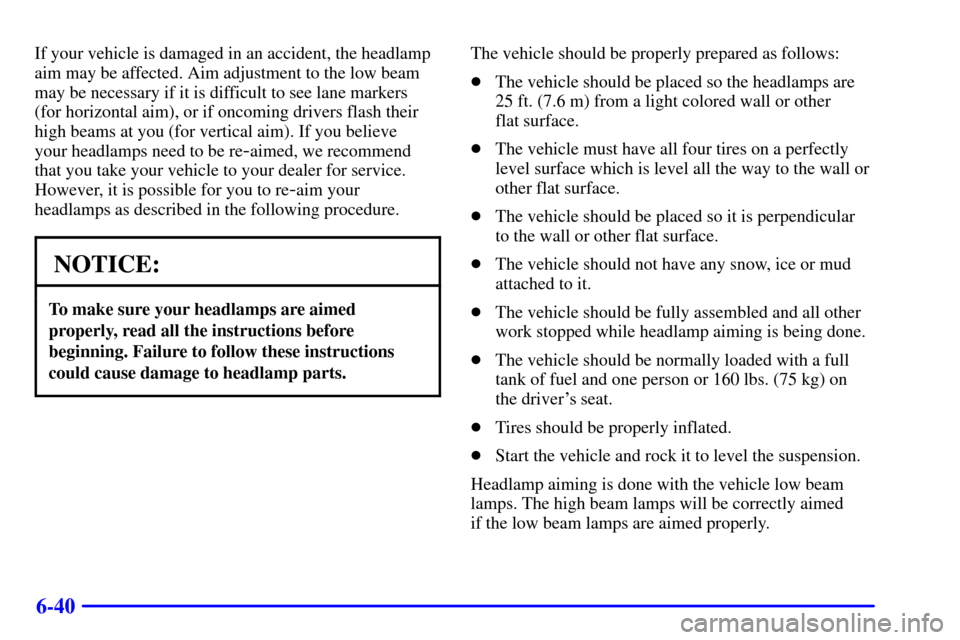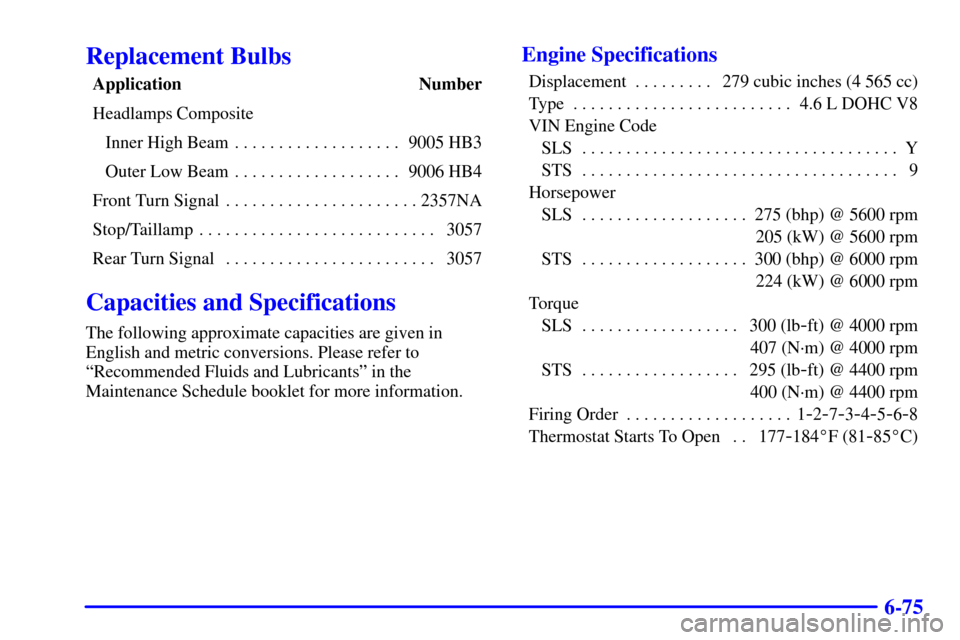Page 318 of 371
6-36
Bulb Replacement
For the proper type of replacement bulb, see
ªReplacement Bulbsº in the Index.
For any bulb changing procedure not listed in this
section, contact your dealer service department.
High Intensity Discharge (HID) Lighting
(If Equipped)
CAUTION:
The low beam High Intensity Discharge lighting
system operates at a very high voltage. If you try
to service any of the system components, you
could be seriously injured. Have your dealer or
a qualified technician service them.
Halogen Bulbs
CAUTION:
Halogen bulbs have pressurized gas inside
and can burst if you drop or scratch the bulb.
You or others could be injured. Be sure to read
and follow the instructions on the bulb package.
Page 319 of 371
6-37 Headlamps
1. Open the hood and remove the upper filler panel by
loosening all the screws and then removing the
grommets. You can later reinstall the upper filler
panel by inserting the grommets, along with the
screws, back into the holes.
2. Remove the two bolts fastening the headlamp to the
headlamp mounting bracket.3. Pull the headlamp straight forward to disengage the
locator pin at the outboard edge of the headlamp.
4. To replace the low-beam bulb, first remove the
rubber housing cover on the rear of the lamp.
Page 321 of 371
6-39
7. After removing the wiring harness connector from
the headlamp bulb socket, replace the bulb assembly.
Reconnect it to the wiring harness and reinstall
the headlamp bulb assembly back into the
headlamp housing.
8. After reinstalling the bulb and socket, reinstall
the rubber cover. Make sure it fully covers the
headlamp socket.
9. To replace the high
-beam bulb, turn the bulb socket
counterclockwise to unlock the socket from the lamp
housing. Follow the instructions in Step 6 through 8
to install the new bulb.Headlamp Aiming
Your vehicle has a visual optical headlamp aiming
system equipped with horizontal aim indicators. The
aim has been pre
-set at the factory and should need
no further adjustment. This is true even though your
horizontal aim indicators may not fall exactly on
the ª0º (zero) marks on their scales.
Page 322 of 371

6-40
If your vehicle is damaged in an accident, the headlamp
aim may be affected. Aim adjustment to the low beam
may be necessary if it is difficult to see lane markers
(for horizontal aim), or if oncoming drivers flash their
high beams at you (for vertical aim). If you believe
your headlamps need to be re
-aimed, we recommend
that you take your vehicle to your dealer for service.
However, it is possible for you to re
-aim your
headlamps as described in the following procedure.
NOTICE:
To make sure your headlamps are aimed
properly, read all the instructions before
beginning. Failure to follow these instructions
could cause damage to headlamp parts.
The vehicle should be properly prepared as follows:
�The vehicle should be placed so the headlamps are
25 ft. (7.6 m) from a light colored wall or other
flat surface.
�The vehicle must have all four tires on a perfectly
level surface which is level all the way to the wall or
other flat surface.
�The vehicle should be placed so it is perpendicular
to the wall or other flat surface.
�The vehicle should not have any snow, ice or mud
attached to it.
�The vehicle should be fully assembled and all other
work stopped while headlamp aiming is being done.
�The vehicle should be normally loaded with a full
tank of fuel and one person or 160 lbs. (75 kg) on
the driver's seat.
�Tires should be properly inflated.
�Start the vehicle and rock it to level the suspension.
Headlamp aiming is done with the vehicle low beam
lamps. The high beam lamps will be correctly aimed
if the low beam lamps are aimed properly.
Page 325 of 371
6-43
4. Turn on the low beam headlamps and place a piece of
cardboard or equivalent in front of the headlamp not
being aimed. This should allow the beam cut
-off of
the headlamp being aimed to be seen on the flat surface.
NOTICE:
Do not cover a headlamp to improve beam cut-off
when aiming. Covering a headlamp may cause
excessive heat build
-up which may cause damage
to the headlamp.
5. Turn the vertical aiming screw (C) until the
headlamp beam is aimed to the horizontal tape line.
Page 350 of 371
6-68
Minifuses Usage
1 ALDL
2 Accessory
3 Windshield Wipers
4 Not Used
5 Headlamp Low Beam Left
6 Headlamp Low Beam RightMinifuses Usage
7 Instrument Panel
8 Powertrain Control
Module Battery
9 Headlamp High Beam Right
10 Headlamp High Beam Left
11 Ignition 1
12 Fog Lamps
13 Transmission
14 Cruise Control
15 Coil MDL
16 Injector Bank #2
17 Not Used
18 Not Used
19 Powertrain Control
Module Ignition
20 Oxygen Sensor
21 Injector Bank #1
Page 351 of 371
6-69
Minifuses Usage
22 Auxiliary Power, (Cltr2)
23 Cigar Lighter
24 Daytime Running Lamps
25 Horn
26 Air Conditioner Clutch
Micro Relays Usage
27 Headlamp High Beam
28 Headlamp Low Beam
29 Fog Lamps
30 Daytime Running Lamps
31 Horn
32 Air Conditioner Clutch
Mini Relays Usage
33 Not Used
34 Accessory
35 Not UsedMini Relays Usage
36 Starter 1
37 Cooling Fan Secondary
38 Ignition 1
39 Cooling Fan Series/Parallel
40 Cooling Fan Primary
Maxibreaker Usage
41 Starter
42 Export Use
MaxiFuses Usage
43 Not Used
44 Antilock Brake System
45 Air Pump
46 Cooling Fan Secondary
47 Cooling Fan Primary
The spare fuses are located in numbers 48 through 52.
The fuse puller is located in number 53.
Page 357 of 371

6-75
Replacement Bulbs
Application Number
Headlamps Composite
Inner High Beam 9005 HB3. . . . . . . . . . . . . . . . . . .
Outer Low Beam 9006 HB4. . . . . . . . . . . . . . . . . . .
Front Turn Signal 2357NA. . . . . . . . . . . . . . . . . . . . . .
Stop/Taillamp 3057. . . . . . . . . . . . . . . . . . . . . . . . . . .
Rear Turn Signal 3057. . . . . . . . . . . . . . . . . . . . . . . .
Capacities and Specifications
The following approximate capacities are given in
English and metric conversions. Please refer to
ªRecommended Fluids and Lubricantsº in the
Maintenance Schedule booklet for more information.
Engine Specifications
Displacement 279 cubic inches (4 565 cc). . . . . . . . .
Type 4.6 L DOHC V8. . . . . . . . . . . . . . . . . . . . . . . . .
VIN Engine Code
SLS Y. . . . . . . . . . . . . . . . . . . . . . . . . . . . . . . . . . . .
STS 9. . . . . . . . . . . . . . . . . . . . . . . . . . . . . . . . . . . .
Horsepower
SLS 275 (bhp) @ 5600 rpm. . . . . . . . . . . . . . . . . . .
205 (kW) @ 5600 rpm
STS 300 (bhp) @ 6000 rpm. . . . . . . . . . . . . . . . . . .
224 (kW) @ 6000 rpm
Torque
SLS 300 (lb
-ft) @ 4000 rpm . . . . . . . . . . . . . . . . . .
407 (N´m) @ 4000 rpm
STS 295 (lb
-ft) @ 4400 rpm . . . . . . . . . . . . . . . . . .
400 (N´m) @ 4400 rpm
Firing Order 1
-2-7-3-4-5-6-8 . . . . . . . . . . . . . . . . . . .
Thermostat Starts To Open 177
-184�F (81-85�C) . .